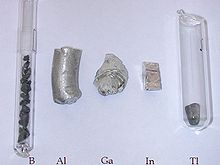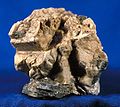Boron group
|
Position in the periodic table
|
|||||||||||||||||||||||||||||||||||||||||||||||||||||||||||||||||||||||||||||||||||||||||||||||||||||||||||||||||||||||||||||||||||||||||||||||||||||||||||||||||||||||||||||||||||||||||||||||||||||||||||||||||||||||||||||||||
| group | 13 |
| Main group | 3 |
| period | |
| 2 |
5 B |
| 3 |
13 Al |
| 4th |
31 Ga |
| 5 |
49 in |
| 6th |
81 Tl |
| 7th |
113 Nh |
The third main group (after the new numbering of IUPAC group 13) of the periodic table is called the boron group (also triele ) . It contains the elements boron (B), aluminum (Al), gallium (Ga), indium (In) and thallium (Tl). The artificially produced radioactive element Nihonium (Nh), formerly also called " Eka -Thallium", is also one of them.
In the past all elements of the boron group were sometimes called earth metals , derived from alumina , an aluminum oxide (Al 2 O 3 ). However, since boron itself is not counted as a metal but as a semi-metal , only the other elements of the boron group are now referred to as earth metals.
Occurrence
The earth's crust consists of 7.3% elements of the boron group, which are mostly present as oxides . Of this, 99.94% is aluminum, the most common metal in the earth's crust . The other elements of the boron group are rare.
These 0.06% break down as follows:
- 51% boron
- 46% gallium
- 3% indium
- 0.2% thallium
Minerals containing aluminum :
Bauxite (mixture of minerals)
Corundum (Al 2 O 3 )
Ruby (form of corundum)
Raw sapphire (form of corundum)
No element of the boron group occurs properly .
properties
The first element of the group, boron, differs significantly from the other elements of the boron group due to its semi-metallic properties, all of which are metals and resemble alkaline earth metals in their properties .
Physical Properties
With increasing atomic number , atomic mass , atomic radius and ionic radius grow . Boron has the highest melting point with 2076 ° C , the lowest gallium with only 29.76 ° C ( body temperature : ~ 37 ° C). In between are indium (156.6 ° C), thallium (304 ° C) and aluminum (660.32 ° C). The boiling points decrease from top to bottom: boron has the highest value at 3927 ° C, followed by aluminum (2467 ° C), gallium (2204 ° C), indium (2072 ° C) and finally thallium (1473 ° C).
As the atomic number increases, the density increases while the hardness decreases. Boron has the lowest density with 2.460 kg / dm 3 and the highest Mohs hardness with 9.3 , with thallium it is exactly the opposite with a density of 11.850 kg / dm 3 and a Mohs hardness of only 1.2.
Aluminum has the highest electrical conductivity with 37.7 M S / m (about a third less than copper (58 MS / m)), while boron has the lowest with 0.10 mS / m.
The 1st ionization energy sinks with increasing atomic number from 8.298 eV for boron to 5.786 eV for indium, whereby gallium is in second place with 5.999 eV (instead of aluminum with 5.968 eV). Thallium has an increased value of 6.108 eV.
The electronegativity is greatest for boron at 2.0, reaches a temporary low point at 1.5 for aluminum and then rises again to 1.8, the value of gallium. In the further course the electronegativity drops again to the value 1.4 (thallium).
At very low temperatures, aluminum, gallium, indium and thallium conduct electricity without resistance . They become superconductors .
| element | Melting point in K | Boiling point in K | Density in kg / m 3 | Mohs hardness | El. Conductivity in S / m |
|---|---|---|---|---|---|
| boron | 2349 | 4200 | 2460 | 9.3 | 1 · 10 −4 |
| aluminum | 933.47 | 2740 | 2700 | 2.75 | 37.7 · 10 6 |
| gallium | 302.91 | 2477 | 5904 | 1.5 | 6.76 · 10 6 |
| Indium | 429.75 | 2345 | 7310 | 1.2 | 11.6 · 10 6 |
| Thallium | 577 | 1746 | 11850 | 1.2 | 6.17 · 10 6 |
Electron configuration
The electron configuration is [ X ] y s 2 y p 1 . The X stands for the electron configuration of the noble gas , which is one period higher , and the period in which the element is located must be used for the y . From gallium there is also a (y-1) d 10 orbital; and from thallium on there is also a (y-2) f 14 orbital.
The electron configurations for the individual elements are:
- Boron: [ He ] 2s 2 2p 1
- Aluminum: [ Ne ] 3s 2 3p 1
- Gallium: [ Ar ] 3d 10 4s 2 4p 1
- Indium: [ Kr ] 4d 10 5s 2 5p 1
- Thallium: [ Xe ] 4f 14 5d 10 6s 2 6p 1
- Nihonium (calculated): [ Rn ] 5f 14 6d 10 7s 2 7p 1
The oxidation state is +3. Only thallium and indium also occur with the oxidation number +1, which with thallium occurs even more frequently than +3.
Chemical reaction
In the following equations, Me stands for an element from the third main group (boron group).
- Reaction with oxygen :
- Thallium also forms Tl 2 O
- Reaction with hydrogen (not spontaneous):
- Only boron and aluminum react to form (always covalent) hydrogen compounds. In the case of boron, the structurally diverse boranes with diborane (B 2 H 6 ) as the simplest representative are formed through three-center bonding ; the hypothetical monomer BH 3 does not exist. AlH 3 - molecules are by hydrogen bonds connected.
- Reaction with water :
- Only aluminum releases hydrogen from water . However, on contact with air / oxygen, aluminum very quickly forms a passivation layer which protects the metal from reacting with water.
- Reaction in the alkaline:
- - -
- In the alkaline environment, no Al (OH) 3 is formed , but the aluminate ion Al (OH) 4 - .
- Thallium also forms TlCl.
links
-
Oxides (III), hydroxides and acids
- In boron trioxide (B 2 O 3 ) ("anhydrous boric acid") the oxygen is covalently bound. The hygroscopic substance forms the very weak boric acid (H 3 BO 3 ) with water .
- Aluminum oxide (Al 2 O 3 ) (“clay”) is also a hygroscopic substance that is soluble in acids and bases . With water it forms aluminum hydroxide (Al (OH) 3 ), an amphoteric compound.
- Gallium (III) oxide (Ga 2 O 3 ) forms gallium hydroxide (Ga (OH) 3 ) with water .
- Indium (III) oxide (In 2 O 3 ) and water form indium hydroxide (In (OH) 3 ), a compound with a basic reaction.
- Thallium (III) oxide (Tl 2 O 3 ) reacts with water to form thallium (III) hydroxide (Tl (OH) 3 ), which is also basic .
- Hydrogen compounds
- Boranes ((BH 3 ) n ) are liquid or gaseous and have an unpleasant odor. They are mostly poisonous , explosive and very reactive. Two boron atoms and two hydrogen atoms are held together by only two pairs of electrons , which means that two three-center bonds of the form BHB can be recognized.
- Aluminum hydride ((AlH 3 ) n ) ("Alan") is a high-polymer powder that is sensitive to air and moisture and disintegrates above 100 ° C. The AlH 3 molecules are coordinated by hydrogen bonds .

- other:
- Carboranes are carbon-containing boranes (mostly B 10 C 2 H 12 )
- Boron carbide (B 13 C 2 ) has a higher scratch hardness than diamond and is used as an abrasive or as a material for wear-resistant objects.
- BN: Compounds of boron with nitrogen in a ratio of 1: 1 are very similar in their structure to the modifications of carbon, since the electron pair missing in boron is contributed by nitrogen.
- Boron nitride has a layer structure similar to graphite .
- Borazon ( inorganic diamond ) is a very hard compound with diamond lattice.
- There is also a fullerene-like modification.
- Aluminum chloride (AlCl 3 ) is hygroscopic and smokes in moist air. The smoke consists of the hydrolysis products hydrochloric acid (HCl) and aluminum hydroxide (Al (OH) 3 )
- Aluminum sulfate (Al 2 ( SO 4 ) 3 · 12 H 2 O ) forms colorless crystals. The anhydrous form is a white powder.
- Aluminum alloys improve the technical properties of aluminum. The better known are Dural (4% Cu , 0.3% Mg , 1% Mn and 0.5% Si ), Magnalium (3–9% Mg) and Silumin (max. 14% Si)
- Gallium chloride (GaCl 3 ) forms colorless crystals.
- Gallium (III) compounds with elements of main group 5 are semiconductors .
- Gallium nitride (GaN)
- Gallium phosphide (Ga P )
- Gallium arsenide (Ga As )
- Gallium antimonide (Ga Sb )
- Some gallium alloys are superconductors .
- V 3 Ga ( transition temperature 16.8 K)
- Nb 3 Ga (transition temperature 14 K)
- Zr Ga 3 (transition temperature 10 K)
- Indium (III) chloride (In Cl 3 ) forms hygroscopic crystal platelets. In the gas phase it is (like all indium halides ) as a dimeric molecule. The compound often forms double salts with the chloro complex InCl 6 3− .
- Alloys with the elements of the 5th main group serve as semiconductors. They are used as ferromagnets in transformers and coils .
- Thallium (I) sulfate (Tl 2 SO 4 ) forms colorless, highly toxic crystals.
- In the sodium thallide ( Na Tl) the Tl - ions form a diamond lattice, in the interstices of which Na + ions are embedded (see also Zintl phases ).
- Thallium (I) alkoxides are formed from alcohols and thallium and form cube-shaped tetramers.
- Thallium (I) oxide and thallium (I) hydroxide
literature
- Hans Breuer: dtv-Atlas Chemie (Volume 1: General and Inorganic Chemistry) (2000), pp. 114–129, ISBN 3-423-03217-0 .




















